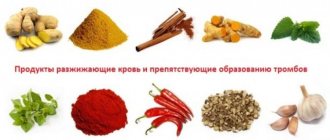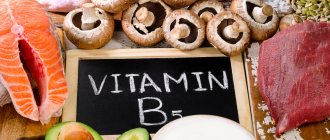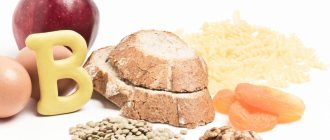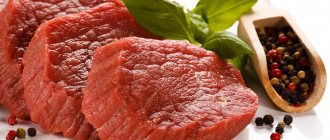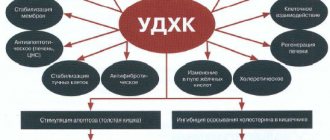Foods Rich in Vitamin C
Vitamin C is found in plant foods - vegetables, fruits, berries. It has always been believed that the highest dosages of vitamin C are found in citrus fruits, and the more acidic the citrus, the more “ascorbic acid” it contains. This is completely wrong!
Firstly, a sour lemon contains one and a half times less vitamin than a sweet orange, and secondly, both fruits contain little of it - about the same amount as apples. There is much more vitamin in dill, walnuts, rose hips, and sea buckthorn. They should be used intensively for viral diseases, instead of endlessly drinking tea with lemon.
General importance of vitamins for humans
These substances take an active part in many processes that affect the functioning of the body. One of their main purposes is to participate in metabolism and create optimal conditions for the normal course of physiological processes.
But if any vitamins are missing, this leads to vitamin deficiency. To prevent this from happening, you need to take various supplements. They can also be obtained from food. But every vitamin has an antivitamin that reduces the activity of a biologically active substance. This nuance must be taken into account when planning your diet.
Increased need for vitamin C
In pregnant women, the need for it increases by about 10 mg, and in nursing women - by almost half. Also, increased amounts of vitamin C are needed by smokers and those who are exposed to harmful occupational factors.
During acute illnesses, it is permissible to consume up to 10 daily norms at a time! When recovering from various diseases, under high loads, in the cold season, you also need more vitamin C than usual.
Although many situations require increased use of vitamin C and the use of high dosages, it is not recommended to increase doses indefinitely. When consuming more than 2 g of the substance per day, a toxic effect of ascorbic acid on kidney tissue is observed.
pixabay.com/pasja1000 Is it possible to overdose on vitamin C?
If you only get the substance from food, it is impossible to overdose. Ascorbic acid is not retained in the body. It is distributed in the tissues and excreted in the urine and then daily.
An overdose is possible if you take ascorbic acid tablets in large doses (more than 2000 mg per day). In this case, an excess of the substance can provoke the formation of kidney stones or an oversaturation of the body with iron. Therefore, when taking ascorbic acid in dosage form, you should follow the dosage and doctor’s recommendations.
Biological role of vitamin C
The functions of vitamin C are numerous, and they make its use very important for maintaining and improving health. The meaning of ascorbic acid is as follows:
• Is an antioxidant. This means that the substance resists the destructive process of lipid peroxidation in tissues, protects the body from diseases and aging. • Strengthens the immune system, increases its “alertness” against harmful microorganisms, especially viruses. • Promotes the full formation of connective tissue, strengthens bones and joints. • “Helps” folic acid, vitamin A, and iron to be absorbed and exhibit their effects. • Improves skin condition. Thanks to its independent anti-inflammatory effect, it reduces the severity of inflammation in acne and acne. • Reduces bleeding, strengthens blood vessels. • Prevents the rapid development of atherosclerosis, inhibits the growth of cholesterol plaques in blood vessels. • Reduces the toxicity of alcohol, improves detoxification, neutralization of many toxic and harmful substances: components of tobacco smoke, substances that pollute water and air, drug metabolites, etc. • Reduces the negative impact of stress on health. • Accelerates the restoration of various tissues when they are damaged. • Has a brightening effect on the skin.
Functions in the body
The main role of ascorbic acid in the human body is the fight against radicals and antioxidant effect. It is also a powerful antioxidant, as it protects internal organs and tissues from possible damage and the development of cancer.
What is vitamin C for? With its participation, redox processes occur in the body, protein synthesis occurs, and connective tissues are strengthened. Vitamin C accelerates the healing of wounds and scars and has a positive effect on epithelial regeneration.
It is important for athletes to regularly take vitamin and mineral complexes containing ascorbic acid, since it normalizes energy processes and increases endurance. The synthesis of steroid hormones, the metabolism of folic acid, and some metals cannot do without vitamin C. In bodybuilding, the substance is valued for its role in gaining muscle mass, since the level of absorption and processing of protein depends on it.
The importance of ascorbic acid for the body cannot be overestimated. Vitamin C strengthens blood vessels and promotes better permeability of important elements through their walls. If vitamin C is present in the body in the right amount, inflammatory processes occur in a lighter form.
The absorption of iron thanks to vitamin C improves, and the blood is provided with an antianemic factor.
The immune system works at full strength in the presence of three main vitamins: A, C, E. Ascorbic acid is responsible for the functionality of protective cells; if there is enough of it, the immune system resists any foreign agents: viruses, bacteria, parasites.
Oncology is considered the plague of the 21st century; statistics show that the number of cancer cases is steadily growing. Oncologists say that with normal levels of vitamin C in the body, a natural fight against cancer cells occurs. However, if a surplus of ascorbate forms in the body, mutating cancer cells become more resistant, even radiation therapy does not kill them. Cancer patients are advised to maintain vitamin C at the proper level.
Ascorbic acid protects the liver from the effects of toxins, removes copper, radioactive substances, mercury, and lead. To prevent the development of diseases of the gastrointestinal tract, ascorbate has become an indispensable remedy. By controlling the level of the substance in the body, there is a chance to avoid cancer in the colon and bladder.
Acid normalizes the functionality of the nervous system, the body gains resistance to stress, and the strength to resist pathogens appears. In addition, the work of the adrenal glands is balanced and the required amount of hormones responsible for combating stress is produced. This is not all that ascorbic acid is responsible for.
It is impossible to give an objective assessment of the effect of vitamin C. In the twenty-first century, science does not know all the properties that a substance has. Do not underestimate control over the level of ascorbic acid in the body, since its deficiency causes the development of chronic diseases.
Signs of vitamin C deficiency
Vitamin C deficiency is common and its symptoms are familiar to many people. Among the signs of hypovitaminosis C, there may be such phenomena as a tendency to bleeding gums, easy formation of bruises on the body, frequent incidence of colds, a predisposition to exacerbations of existing chronic diseases, slow healing of injuries and delayed recovery, discomfort in the joints, problematic skin, hair loss, nosebleeds etc.
With a critical deficiency of the vitamin, a disease known as scurvy develops. It is rare in the modern world, but used to be extremely common. Patients experienced frequent bleeding, teeth falling out, and serious damage to joints and bones.
Excess ascorbic acid in the human body
Ascorbic acid is extremely beneficial for humans, but in large quantities it can cause irreparable harm. The body functions normally only when it receives the required amount of vitamins and minerals, not exceeding the permissible norm. Excess and deficiency become impetus for undesirable processes that affect the overall health.
Consequences of excess ascorbic acid:
- Diarrhea.
- Destruction of blood cells.
- The simultaneous consumption of vitamin C and aspirin leads to irritation of the gastric mucosa and even the formation of erosion and ulcers. Aspirin causes increased consumption of ascorbic acid, which is excreted in the urine through the kidneys. Such a loss becomes the first sign of a serious vitamin deficiency.
- A high dose of vitamin C interferes with the absorption of vitamin B12, which is used as a dietary supplement. B12 deficiency has an extremely negative effect on the body, so its level should be regularly monitored by a doctor.
- Candies and chewing gums with a high content of vitamin C damage tooth enamel, so after eating them, be sure to brush your teeth and rinse your mouth.
- Excessive doses of ascorbic acid slow down the functioning of the pancreas, which is dangerous for patients with diabetes and people with anemia, thrombophlebitis, and thrombosis. Vitamin C influences the formation of a separate group of hormones that affect the functioning of the kidneys and blood vessels.
Ascorbic acid is freely available in stores and pharmacies, and can be purchased without a doctor's prescription.
Excess vitamin C has negative consequences that are as serious as deficiency.
Factors influencing the vitamin C content of foods
Ascorbic acid is a “fragile” vitamin. Upon contact with air, it oxidizes, which leads to some loss of its properties. For this reason, food containing vitamin C is not recommended for long-term storage. Fruit and vegetable juices should be drunk freshly squeezed.
The vitamin is also destroyed when exposed to high temperatures; cooking leads to almost 100% loss of this substance. Therefore, vegetables and fruits should be consumed fresh.
Some of the ascorbic acid is retained in products when frozen; a minimal amount of it “survives” when dried. The destruction of the vitamin is also observed in light. This means that you need to use dark, cool places to store vegetables.
Important fact. The vitamin C content of different products depends greatly on their shelf life. The maximum amount of ascorbic acid is present in ripe, fresh fruits. Meanwhile, kiwis, oranges, and lemons that “come” to our country were collected long before they reached optimal ripeness, and more than 2 months can pass from their collection to consumption. Accordingly, they lose most of their beneficial properties and vitamin C.
As a result, in order to meet the daily requirement for ascorbic acid, a person needs to eat several kilograms of plant foods daily. This is impossible. And this is precisely what leads to the fact that most of us live in conditions of chronic hypovitaminosis and need to take additional dosages of vitamin C.
Vitamin C. How to understand it?
V. Prozorovsky, professor, doctor of medical sciences
“Science and Life” No. 8, 2007
“What do you have here? - Smoke asked one of those lying... - Smallpox, or what? Instead of answering, the man pointed to his mouth, stretched his swollen lips with effort, and Smoke involuntarily recoiled. “Scurvy,” he said quietly to the Kid, and the patient nodded to confirm his diagnosis. “Is there enough food?” - asked the Kid. “Yeah,” replied the man from the other bed, “you can take it.” There’s plenty of food.”
D. London. Smoke and Baby. 1912
As an independent, widespread and fatal disease, scurvy (scorbut) was described in detail in the Middle Ages. It fell on people like the scourge of God during long sea voyages, protracted wars (Crusades, sieges of cities), in areas suffering from crop failure. Later, she threatened polar expeditions and gold prospectors in the northern lands with death. Now in the spring he visits the northern regions in the form of hypovitaminosis. In addition to general exhaustion, impaired strength of the vascular wall, and with it hemorrhages and bleeding, anemia, ulcerative skin lesions, tooth loss, destruction of cartilage, joint pain and other delights, with scurvy, immunity decreases and fever occurs. Since, moreover, the disease was clearly focal in nature, many considered it contagious. Others associated scurvy with poor quality food and mental depression. With partial fasting, the whole range of scurvy symptoms develops over several months. And in case of infectious diseases, especially influenza, the first signs (hemorrhages) of vitamin deficiency appear within a week.
For the first time, the presence in natural food of some special substances necessary for the life of animals was proven by the Russian pediatrician N.I. Lunin in 1881. His work (dissertation) was a major discovery, since it refuted the accepted as a law opinion of the great chemist J. Liebig (“Organic chemistry in its applications to physiology and pathology,” 1842) that proteins, fats, carbohydrates and mineral salts are quite sufficient. No, it’s not enough, more substances are needed, Lunin said, and thus opened a new era in the problem of nutrition and medicine.
Why vitamin?
In the 19th - early 20th centuries, East Asia with its Polynesian and Japanese islands was the focus of a severe endemic (inherent in a given limited area) beriberi disease (alimentary polyneuritis). It is characterized by damage to peripheral nerves, the cardiovascular system and edema, followed by muscle atrophy. Thus, in 1911 in Java and Sumatra, the mortality rate from beriberi reached 70%. In Japan, it affected mainly sailors - an average of 300 per 1000 people per year. Everyone seemed to live together on the ships, but the officers ate better and got sick less often, so the doctors assumed that the illness was somehow related to diet.
In June 1897, the Dutch doctor H. Eijkman, who served in the colonial administration, drew attention to the fact that chickens bred in the nursery at their institute in Batavia (as Jakarta was previously called) developed a disease reminiscent of beriberi in humans, — they seemed unable to walk and were constantly tumbling. Aikman noted: the disease began from the time when chickens began to be fed husked (polished) rice. He did not find microbes in their corpses, but in the nerves and spinal cord of chickens the same degeneration of nerves was noticed as in humans - the result of polyneuritis. Transferring the chickens to a normal diet led to a rapid recovery. Similar results were described in observations of the health of prisoners in different prisons. And there, transferring patients to feeding regular rice led to the elimination of the disease. For this find, H. Eikman, together with his colleague F.Kh. Hopkins received the Nobel Prize in 1929. All that was found out was that in some Batavia something necessary for health was found in the bran of rice. But they got sick all over the world, especially in the north, where there was no smell of rice, especially polished rice. So what was it?
Back in 1911, the Polish biochemist K. Funk, working in London, isolated a special dry substance from rice bran, 20 mg of which cured patients from beriberi. This substance, along with carbon and hydrogen, contained 8% nitrogen. It is for this reason that Funk proposed calling it the amine of life (vita in Latin) - a vitamin (without any letters yet). Subsequently, he isolated the same substance from yeast, milk, cow brain and lemon juice. The scientist wrote: “...to the well-known list of food elements—proteins, fats, carbohydrates, purines and mineral salts—a new group must be added, namely, “vitamins.” He called diseases caused by their absence, in particular scurvy and rickets (there was no trace of C and D yet), vitamin deficiencies. For me, it was Funk who made the real discovery of vitamins, but... the ways of the Nobel Committee are inscrutable.
Where does "S" come from?
For C to appear, A and B are first needed. In 1909, the German scientist W. Stepp reported that when mice are fed bread made with milk, the animals develop well. However, if fat is extracted from this bread using an organic solvent, the mice wither and die. If you add the extracted substance to low-fat milk bread, then they live, cheerful and vigorous. Adding vegetable oil did not have this effect, therefore, you need something fatty, but not just any fat.
Later, in 1914, the Englishmen E. McCall and M. Davis established that the necessary fat was found in butter and egg yolk. In 1919, the authors proposed to call this substance “fat-soluble factor “A”. Subsequently, it was found that the absence of factor “A” in food leads to dryness and ulceration of the cornea (xerophthalmia), and substance “A” began to be called “axerophthalmine”. A year later, it began to be used to treat retinal diseases (retina in Latin) and was already called vitamin A - retinol. That's his name now.
A year later, the same E. McCall and M. Davis discovered a “vitamin-like water-soluble substance” necessary for the growth of rats, which, alas, turned out to be identical to the vitamin used to combat beriberi. At the suggestion of the same Funk, this antipolyneuritis vitamin was designated the letter B. Less than a dozen years have passed since the number of B vitamins has increased. The first (the same one) naturally became B1, and then came B2, B3, etc. All B vitamins are united by water solubility and thermolability (sensitivity to temperature). This is how they differ from fat-soluble and heat-stable vitamin A.
A. Szent-Györgyi, who discovered vitamin C. He received the Nobel Prize in 1937 for his work on oxidation, including the discovery of ascorbic acid (image: Science and Life)
In reality, scurvy was reproduced in animals, namely guinea pigs, only in 1910 by A. Holst and J. Fröhlich. It all started with feeding experimental animals exclusively oatmeal, and then it turned out that any grain mono-diet is scurvy. Then they clarified that although the antiscorbutic factor is absent in cereal grains, it appears in green sprouts. It is present in juicy vegetables, fruits and plants in general, although in different quantities. It is also found in milk, but only in fresh milk, and is destroyed during sterilization. This is why pasteurization was invented: after it, the anti-scorbutic effect of milk decreases, but does not disappear. In 1920, I. Drummond proposed calling the antiscorbutic substance vitamin C. A very curious circumstance soon became clear - it turns out that only guinea pigs, apes and, naturally, their closest relative, humans, suffer from scurvy. In 1922, researcher N.A. Bessonov was the first to isolate an active antiscorbutic drug from white cabbage juice. Although it was not sufficiently purified, the experimental scurcutus healed in insignificant doses. (By the way, Bessonov is not even mentioned in the Great Medical Encyclopedia.) After its publication, a large series of works by many authors followed with the results of gradual purification of the drug and clarification of its properties, and only in 1933 the German biochemist F. Michel and the Hungarian scientist A. Szent -Györgyi established a formula for an antiscorbutic vitamin isolated from lemons. Szent-Györgyi later gave it the name "ascorbic acid" (he received the Nobel Prize in 1937).
The main concern of ascorbic acid
It seems natural that the main property of ascorbic acid is to prevent and heal scurvy. But only humans and others like him need it, and in all other animals (except the guinea pig), ascorbic acid is synthesized in the liver from sugars. Why? There are many reasons, but, first of all, in order to prevent a living organism from flashing a blue light, to help the necessary oxidation and to resist dangerous oxidation. We are always balancing on a razor's edge: slow oxidation is life, fast oxidation is death!
Crystals of ascorbic acid under a microscope. Photo by M. Davidson. Florida State University, USA (image: Science and Life)
All types of our activities require energy and all of it - chemical, mechanical, electrical, nervous and even mental - is born from the oxidation that oxygen carries. Not everyone can hold their breath for more than a minute. 5 minutes after oxygen supply to the brain stops, it dies. The difficulty is not only that oxygen is needed, but that it is needed only for those processes that are included in the energy metabolism chain. And these processes occur exclusively intracellularly with the participation of a number of enzymes, and the process of biological oxidation occurs not due to the direct interaction of oxygen with combustible material, but by the transfer of electrons from the oxidized substance - carbohydrates and fats - to the oxidizing agent - oxygen through a chain of enzymes. What does ascorbic acid have to do with it?
In the animal body, the chain of enzymes and substrates through which electrons are transferred, and with them oxidation energy, is long and diverse. But such a chain necessarily includes adenosine triphosphoric acid (ATP), which is the main and unique chemical battery, capable of, under the influence of enzymes and as a result of various transformations, directly transferring the energy accumulated in ATP to chemical, electrical, and mechanical processes. Carbohydrates and fats are also energy accumulators - 4.1 and 9.3 kcal/g, respectively, but without biological slow oxidation they can only burn, giving heat and light, but cannot be directly converted even into mechanical energy, not to mention mental .
However, in biological objects everything does not always proceed as it should. Oxygen can acquire not two, but one electron, which leads to oxygen instability and increased reactivity. The presence of an extra electron in an atom is conventionally indicated by a dot at the top of the element symbol.
For a number of reasons, most often external (excess ultraviolet radiation, poisoning, radiation damage, some diseases), first single activated atoms—radicals—can appear, and then their chains.
Vitamin C molecule model. Black
- carbon,
red
- oxygen,
white
- hydrogen (image: Science and Life)
And then there is a branching of the chain, which gives rise to more and more new radicals that activate individual atoms, and then large molecules. This process not only ramifies, but also accelerates. The theory of the phenomenon, both in general and in particular, including ignition and explosions, was developed by our compatriot and almost contemporary Nikolai Nikolaevich Semenov (Nobel Prize 1959).
Fortunately, in living organisms it does not come to combustion. But there are burns. A fair-haired blonde will lie down for a couple of hours under the southern sun and get a burn, sometimes to the point of blisters. For other reasons, easily oxidized fats and fat-like substances - lipids of internal organs - suffer from the rapid accumulation of atoms and molecules of active oxidants - prooxidants. Occurring in tissues, prooxidants interact primarily with the fatty membranes of the cells lining the blood vessels—endothelial cells. They oxidize and seem to foam. This is not enough; there are fat-like substances in the blood - low-density lipoproteins, which oxidize more easily than others. When oxidized, they cause destruction of endothelial cell membranes more strongly than other pro-oxidants. Cells are destroyed, and non-destructible cholesterol accumulates in the intercellular spaces. Following this comes atherosclerosis. This is not the only, but the main theory of its origin today.
By the way, polycyclic chlorinated hydrocarbons, including simple polyvinyl chloride PVC, but even simple carbon tetrachloride, as well as carbon monoxide, hydrogen sulfide and other delights of vehicle exhaust gases, can serve as initiators of the formation of active radicals.
Formula of ascorbic acid C6H8O6 - c-vitaminum
(image: Science and Life)
Skin burns under ultraviolet radiation, lungs burn when ozone is inhaled, and hydrogen peroxide generally kills all living things. Salvation from such a scourge is ascorbic acid synthesized by living organisms. That is, for all normal organisms - ascorbic acid, synthesized by themselves, and for the human body - vitamin C. This is our main defense - an antioxidant that protects the entire body and, first of all, all fat-like substances - lipids - from peroxidation. Lipid peroxidation as a biochemical concept is now so widespread that in medical literature it sometimes appears even without decoding - LEX.
Ascorbic acid is an antioxidant because it is an active reducing agent that has the ability to easily oxidize and thereby eliminate reactive oxygen species - “extinguish matches.” This reaction is not simple. Regular ascorbic acid is its reduced form. By reacting with the active oxygen and hydrogen atom, ascorbic acid itself becomes a radical, but... inactive. If the simple radical is R, the oxidized active radical is RO•2, then:
RO•2 + AK-OH = ROOH + AK-O•.
The peculiarity of the resulting AK-O radical is its low activity, which prevents its further transformations and interrupts the reaction chain, and especially its branching. Quenches the reaction. But how so? It seems like a radical is a radical. Where does the low activity of ascorbic acid come from? All acids also seem to have the same hydrogen ion. But you can eat ascorbic acid with a spoon, but it’s better to deal with nitric acid with gloves, and even under traction. Oxidized AK-O can again be converted into a reduced form, or it can be oxidized further, transforming into dehydroascorbic acid, which is then converted in complex ways into oxalic acid or partially reduced.
We should not forget that the ascorbic acid molecule is complex, and it is not just a carrier of a radical, but an enzyme. Its activity as a flame arrester is amazing - in 1 second it eliminates 1010 molecules of active hydroxyl or 107 molecules of superoxide anion radical oxygen. Alas, with food we receive mainly ascorbic acid in an already oxidized form (the longer the food is stored, the more it is oxidized). The content of ascorbic acid in main products is given in table. 1.
Table 1.
Vitamin C content in the most vitamin-rich foods (image: Science and Life)
The most delicious and healthy vitamin C preparation is holosas. These are not only rose hips, but also a choleretic agent that has never harmed anyone. And the benefits!
More than just an antioxidant
Ascorbic acid is an obligatory component (this is called a cofactor) of the activity of enzymes involved in the synthesis of nerve impulse transmitters in the brain, dopamine, adrenaline and norepinephrine, therefore, with vitamin deficiency - a lack of vitamin C - mental activity decreases and even depression develops (early spring depression).
Vitamin C activates the synthesis of collagen, the main protein of connective tissue. And if there is not enough of it, decay and collapse begins: the teeth no longer stay in their sockets, the articular cartilage softens, the sternum moves away from the ribs, the vessels do not hold blood well, hemorrhages occur in the joints, which leads to their stiffness and pain, bones break, and fractures do not occur. grow together.
Relatively recently, it was established that ascorbic acid is a participant in the synthesis of carnitine, which is a substance necessary to ensure the oxidation of fats, as they say in everyday life - combustion. But fats are a source of energy. Their deficiency causes weakness and then exhaustion. Weakness is partly associated with the development of anemia. The fact is that ascorbic acid, by taking on electrons, facilitates the absorption of iron, and therefore accelerates the formation of hemoglobin. There is no ascorbic acid - there is little iron in the blood - there is iron deficiency anemia (in the past it was called the offensive term “pale sickness”).
Previously, nitric oxide - NO - was considered only a poisonous gas, but recently it has been recognized as a participant in numerous beneficial reactions, including a substance that promotes vasodilation. R. Furchgott received the Nobel Prize for this discovery in 1998 (see “Science and Life” No. 2, 1999, No. 7, 2001). Thanks to him, the famous Viagra was created. So, ascorbic acid both promotes the synthesis and protects NO from inactivation (loss of biological activity). Thus, if not a mini-Viagra, then it is a protector against hypertension - that’s for sure. Considering that ascorbic acid also has an anti-sclerotic effect, it is clear that old people need it more than young people.
Common diseases in which hyperoxidation plays a role, in addition to atherosclerosis, include cataracts, some forms of anemia and even cancer. If not in the treatment of these diseases, then there is no doubt about the effectiveness of the preventive action of ascorbic acid.
Table 2.
Prophylactic doses of ascorbic acid (image: Science and Life)
Observations of the life activity of thousands of people indicate that regular intake of multivitamins, including ascorbic acid, from mid-winter to autumn is necessary: this protects against vitamin deficiency and improves health. But you need to take vitamins only in preventive doses (see Table 2).
How to take ascorbic acid
If the need for ascorbic acid is increased, if only because of age, then it is oxidized in larger quantities than usual, and when oxidized, it itself becomes an oxidizing agent, albeit not very active, but still with an extra electron in the outer orbit, that is dangerous. In this case, ascorbic acid must be restored, for which there are other mechanisms inherent to humans. In such situations, it is necessary to take another vitamin, which itself works and restores ascorbic acid. This is vitamin E - tocopherol (translated from Greek as “bearing childbirth”). It is named so because if it is deficient in a woman’s body, miscarriages occur. It is better to buy tocopherol in an oil solution and take 1 drop per day. Regularity is not necessary as it is deposited and used gradually.
The most “ascorbine-containing” products (image: Science and Life)
It is very significant that soon after the isolation and synthesis of ascorbic acid, the effectiveness of the powder began to be compared with lemon. And... for scurvy in pigs, lemon turned out to be much more effective. Naturally, they decided that C alone was not enough. And they also found vitamin P in lemon (from English permeability
- permeability). Permeability vitamin C and P should be taken together. Such tablets are called “askorutin”: “asko” comes from the name of the acid, and “rutin” comes from the word “ruta” - buckwheat. Vitamin P as a substance is called “quercetin”, but it has many other names (that which is obtained from lemon is called “citrine”). And all because many plant substances - flavonoids - have P-vitamin properties, but most of them are found in citrus fruits. Recently, “craftsmen” have obtained another derivative of quercetin, which is 10 times weaker than quercetin, and is sold under the name “capilar” (that’s right) for 10 times more expensive. For capillary toxicosis (inflammation of the capillary walls), the drug venorutin in ampoules is used.
Is ascorbic acid always safe?
As for the recommended (and even slightly larger) doses, they are not only useful, but sometimes necessary, since the need for ascorbic acid increases under any stress, physical and mental stress, and almost any disease.
But in addition to vitamin deficiency, there is also hypervitaminosis (excess vitamin). For some, such as vitamins A, D, K, it is a disease; for most, including vitamin C, it is a nuisance. Excess ascorbic acid can lead to its accumulation in an oxidized form, when it itself becomes an oxidant. At the same time, the absorption of glucose is impaired - pseudodiabetes occurs. A seemingly necessary reduction in blood clotting can lead to bleeding; an increased content of ascorbic acid in the blood violates the results of studies of some of its biochemical parameters, in particular glucose, bilirubin, activity of transferases (enzymes), etc.
There may be other kinds of troubles. Most of the ascorbic acid is reduced after oxidation, but a smaller part is excreted in the urine in the form of oxalic acid. Even if grams are withdrawn, but only 3-4 days - one conversation. But if the excess is constantly removed every day, and even with oxalic acid diathesis, then not only the kidneys, but also the bladder can be clogged with stones.
It has been shown that long-term (three months) intake of ascorbic acid 500 mg per day reduces the content in cells of one of the most dangerous endogenous mutagens - 8-hydroxyguanine. This is good! But taking ascorbic acid in the same dose for six months increases the content of the active mutagen 8-hydronsiadenine. But this is already bad. Although it is believed that the positive influence outweighs the negative, it is not worth the risk.
An interesting story about ascorbic acid is connected with the name of Nobel laureate L. Pauling. In the 70s of the last century, it was reported that ascorbic acid in large doses, 1–3 grams per day, taken at the first signs of acute respiratory infections, including influenza, could interrupt or at least weaken the course of the disease. Pauling, who was not only an extraordinary man, but also a passionate one, was inspired by this idea. He decided to use his own example to convince humanity that ascorbic acid prolongs life, for which he took it in large doses every day. Yes, Pauling lived to be 93 years old. But this means absolutely nothing. If this were proof enough, then my grandmother, who lived 94 years without even knowing about the existence of vitamin C, proved that it is not needed at all.
Obviously, the truth in Pauling's argument with my grandmother lies somewhere between them, but closer to my grandmother.
Literature:
1.
Davis M. et al.
Vitamin C. Chemistry and biochemistry.
- M., 1999. 2. Mussky S. A.
100 great Nobel laureates.
- M.: Veche, 2004. 475 p. 3. Heller Retal.
Vitamin C: poison, prophylactic or panacea? // TIBS. 1999. Vol. 13. P. 1007-024.
Application in cosmetology
Ascorbic acid, as an antioxidant, is included in anti-aging cosmetics for women. Products based on vitamin C prevent the effects of free radicals on the skin of the face, which is why it is used in the manufacture of anti-aging creams.
The presence of a vitamin in the list of cosmetic ingredients does not guarantee quality, since the amount of the element used is not always enough to produce an effect. The optimal dose in cosmetology ranges from 0.3% to 10%. Professional preparations on the labels contain information about the amount of active substance and the percentage of components.
Due to the sensitivity of the vitamin to light and air, cosmetics based on it are produced in sealed, tinted packaging with a dispenser.
Vitamin C-based facial cosmetics perform the following functions:
- protect the skin from exposure to infrared rays;
- synthesize collagen;
- restore collagen fibers;
- slow down the aging process;
- increase skin tone;
- prevent the appearance of age spots;
- relieve inflammation;
- refresh and improve complexion;
- strengthen vascular walls.
Best materials of the month
- Coronaviruses: SARS-CoV-2 (COVID-19)
- Antibiotics for the prevention and treatment of COVID-19: how effective are they?
- The most common "office" diseases
- Does vodka kill coronavirus?
- How to stay alive on our roads?
In winter, to replenish vitamin C reserves, it is necessary to take vitamin and mineral complexes for the skin.
Ascorbic acid is useful for hair; it gives hair shine and silkiness. Liquid vitamin C in ampoules is added to ordinary shampoo or hair conditioner. Nutrition along the entire length is provided during each wash.
